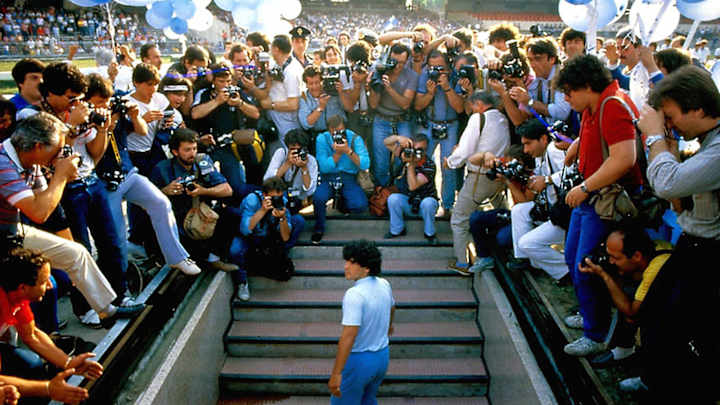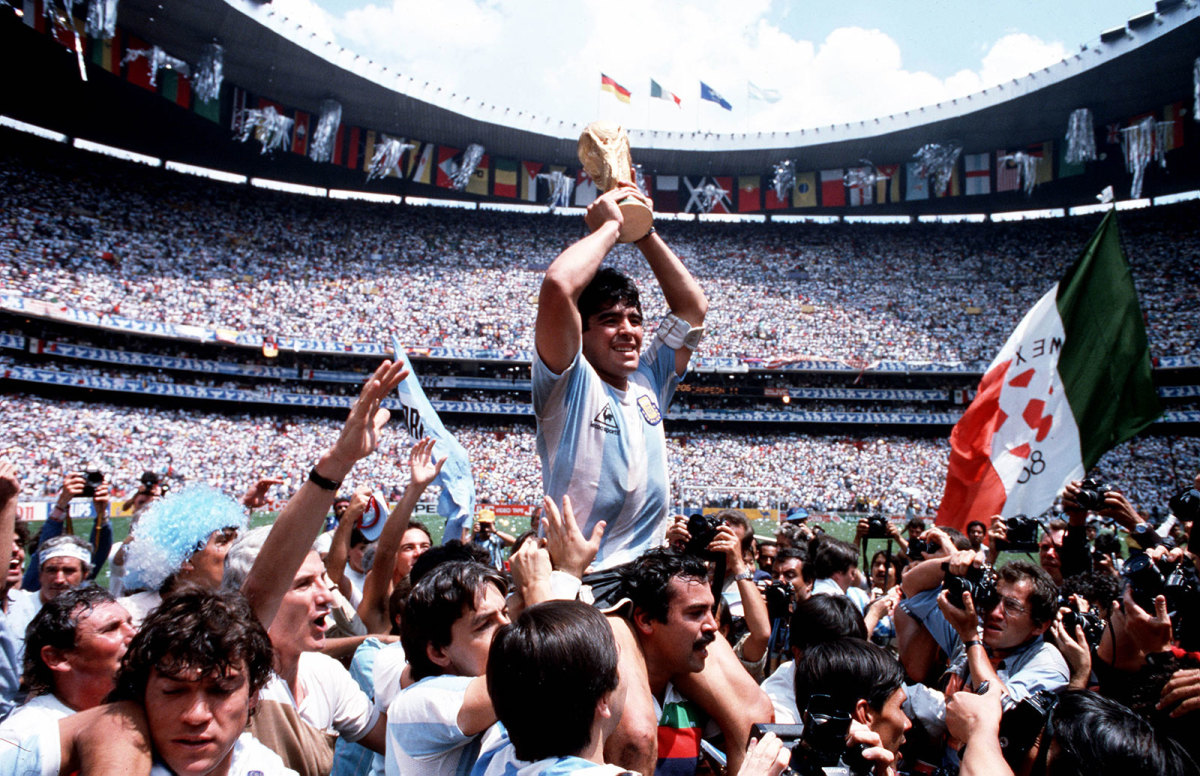New Diego Maradona Documentary Channels Star's Essence at a Pivotal Time

The film begins with a car chase sequence, similar to William Friedkin’s The French Connection or Steve McQueen’s Bullitt. Diego Armando Maradona, a 24-year-old rising and controversial young star leaves Barcelona and arrives in Naples–a city going through financial and social disarray and in need of so much more than a pricey footballer.
As the camera frantically follows the speeding car through narrow streets, clips of Maradona’s life–both past and present–are inserted: One of his mother Doña Tota speaking with pride about her son, another of a young Pelé questioning Maradona’s mentality and if he’s ready to carry the weight of his own reputation.
As the car chase ends, Maradona makes his way inside Napoli’s San Paolo stadium, where more than 75,000 people eagerly await his arrival. It’s the summer of 1984 and finally, after all they’ve been through, Neapolitans have their savior.
He stands at just 5-foot-5, but right now, in this moment, he might as well be a giant.

Maradona grabs the microphone to greet his new fans, madness ensues and fans go crazy. This opening scene, which began with the fast-paced car chase, perfectly sums up how you feel when you watch Diego Maradona, HBO’s magnificent two-hour documentary that tells the story of a man who came from nothing and a city that both built and destroyed him.
Directed by the award-winning Asif Kapadia, the film had its premiere at Cannes Film Festival earlier this year and has its HBO release set for Oct. 1 at 9 p.m.
“Maradona, in many ways, is about a kid from the streets who made it to the top,” Kapadia told SI.com. “So, my films are about how these people lived and what got them to that place. And the centerpiece was always going to be Naples.”
With access to 500 hours of never-before-seen footage thanks to the player’s personal archives, Kapadia’s film breaks down Maradona's time with Napoli from 1984–1992, a time in his life that essentially set the stage for everything else that followed in his career.
"Maradona in Naples is the story of his life," Argentine journalist Daniel Arcucci, who has known and interviewed Maradona throughout his entire career, says in the film. “Rebel. Cheat. Hero. God.”
If Neapolitans were the unwanted of Italy, then Maradona felt as if he represented them and eventually gifted them with joy and success. But he also never expected this level of triumph and in this disbelief of adulation, fame consumed him.
“In making this film, I saw him as a kid. A lost kid,” Kapadia said. “And it’s the vulnerability in his eyes that you see in this film, he looks lost in crowds, and he’s not used to it, that’s what I don’t think we’ve seen before. So that’s what I’m interested in when I make these films. I try and humanize these people who are iconic.”
Much like his previous award-winning films Senna (on legendary, Brazilian three-time Formula One racing champion Ayrton Senna) and Amy (about the life and career of British singer/songwriter Amy Winehouse), Kapadia peels the onion of his progenitor, revealing each characteristic, no matter how imperfect, until you discover exactly who Maradona is, or at the very least, who he wound up becoming.
“He’s part Senna, a Latin American hero, but he’s also part Amy," Kapadia said. "He’s a vulnerable child who just wants love and support. And if you become a football player or a basketball player and you get taken and you get given millions, suddenly you have no education and no support system. So how the hell are you supposed to survive when you’re seen as a god?”
Stylistically, where Kapadia and his team truly succeed is how the footage does the talking and paints a raw, honest picture. There are no talking heads or celebrity narration. It’s just the visuals backed by a smart score, all of which are beautifully edited in order to give the audience an honest, intimate portrait of Maradona.
Kapadia and his team spent three years working on the product, including a personal visit to Dubai to visit Maradona and interview him–but only on tape recorder, which is why viewers will only hear Maradona’s voice in the film–at least as it relates to his modern iteration.
But this works to the film’s favor as Maradona’s voiceover appears honest and vulnerable, helping the viewer understand his state of mind during the most tumultuous time of his career.
Aside from family members and those close to him such as the mother to both of his daughters, Claudia Villafañe (they are divorced but remain close to this day), there are other important characters in the film. There’s Fernando Signorini, Maradona’s personal trainer who cared not just for his physical development but also his mental state during his time in Italy. In many ways, Signorini knew Maradona better than anyone, and his inclusion in the documentary helps us understand more about his psychology, specifically when he became involved with the Camorra–the mafia-like crime syndicate born out of Naples–and the eventual introduction to a world of drugs and prostitution.
Aside from the media and fan obsession, this underworld was also the reason Maradona’s dual personality was born, Signorini says. There was the charismatic player and friend on one side and the cursed superstar on the other.
“With Diego I would go to the end of the world,” Signorini narrates. “But with Maradona, I wouldn’t take a step.”
At his most vulnerable, Maradona could also be so funny and charismatic. There’s a scene, for example, that takes place in 2004 as the Argentine, back in Buenos Aires, is on his way to do an interview with Daniel Hadad for Canal 9. It would be a powerful conversation in which he discusses his family, his drug addiction and his mistakes up to that point.
The camera follows a visibly nervous Maradona, surrounded by people as usual, as he makes his way to the studio. A man yells from above, “Diego, you’re bigger than the Pope!” Without missing a beat, Maradona quickly replies, “That’s not saying much.”
A film about Maradona, however, is not complete without visual reminders of his genius on the pitch, so Kapadia also includes highlights of his matches, specifically his time with Napoli and the 1986 and 1990 World Cups. These clips are stripped to the bare bones, taking away the narration and emphasizing mainly the sounds and gasps of the stadium.

When Maradona played, time stood still. Dribbling for him seemed as easy as taking a breath, and there was almost nothing a defender could do to stop him. Kapadia’s direction, therefore, focuses on this and nothing else.
“Football is the game of deceit,” Maradona says during a specific highlight. “You feint going over there, then you go in the opposite direction, and your opponent goes the other way.” And as he’s talking, he’s showing us exactly how he does it.
And it’s wonderful.
But with beauty also comes pain, and for all the glory we see on the pitch, that is not what Maradona is about. As Kapadia notes, this story is less about talent and more about loss, the curse of fame and how we, as humans, often fail to deal with its alluring qualities.
The story of Maradona, therefore, is a Greek tragedy in which the antihero, unable to control the powers of stardom, falls from grace and eventually fades away.
Eventually, he did return to the spotlight, and the obsession with who many say is the greatest player who has ever lived remains alive. But the reality is that whatever version of Maradona you may want to believe–the drug addict, the poet, the womanizer, the devil, the clown, the hero or the cheat–this film helps us understand that the most important version of the player was the kid from streets of Villa Fiorito who just wanted to play soccer with his friends until the sun went down.
And that version of Diego Maradona is long gone.
